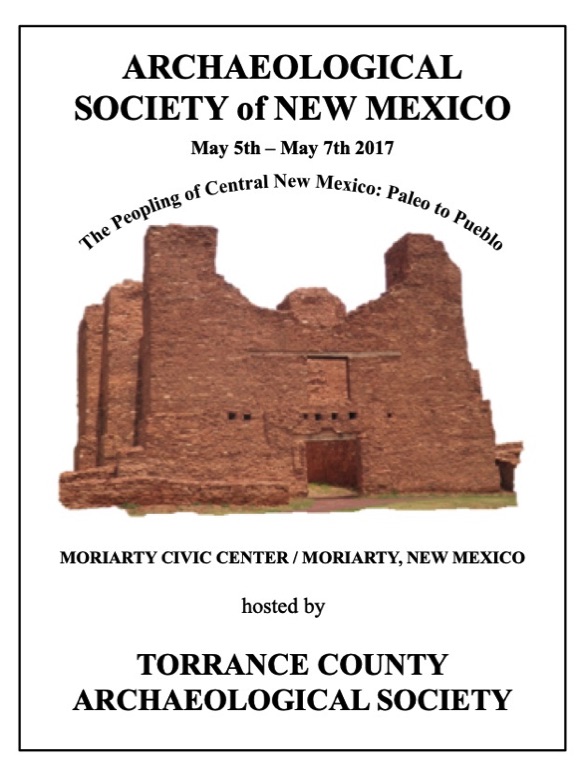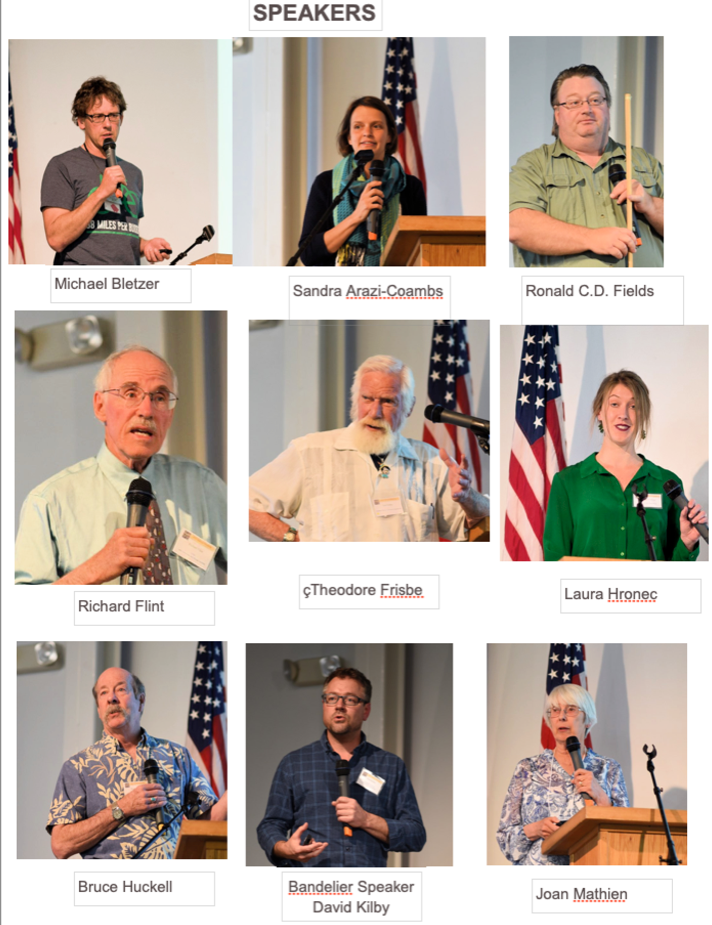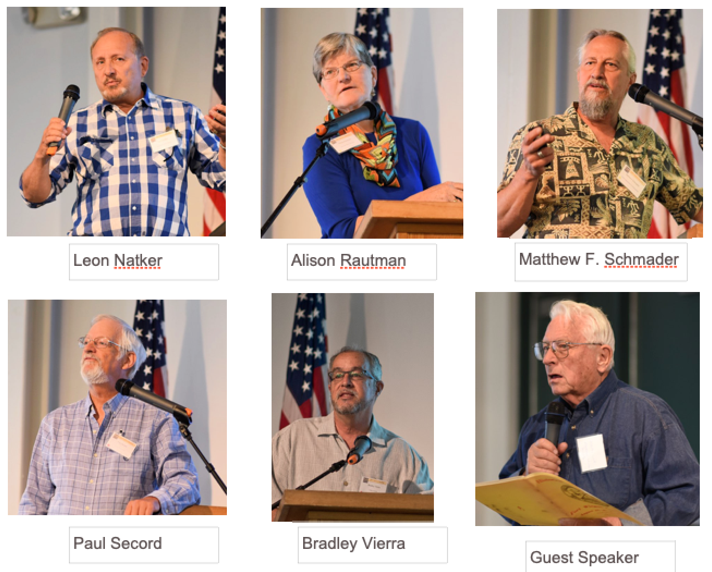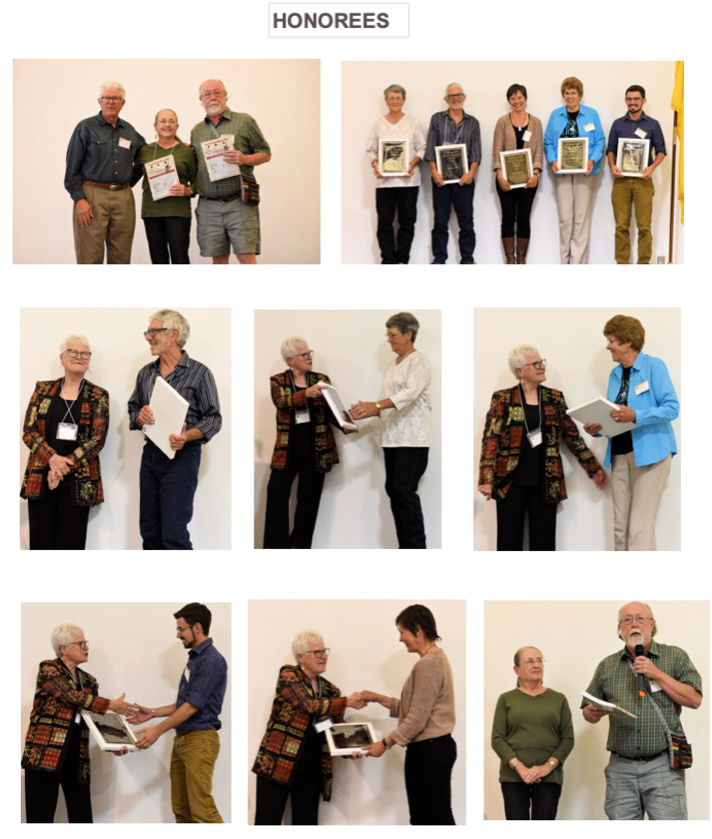
2017 ASNM Meeting Pictures




2017 Field Trips
ASNM 2017 Annual Meeting at the
Civic Center in Moriarty, NM
The Peopling of Central New Mexico: Paleo to Pueblo
May 7th – Sunday Field Trips (Tentative)
Sunday field trip opportunities tentatively will include (1) rock art sites at Abo National Monument not open to the public, (2) the new museum at Tijeras Pueblo, (3) the excavation site under the direction of Michael Bletzer at Sevilleta, and (4) Espantado, also known as Dripping Springs. Sign up for the field trips will take place at the registration desk.
Often, our periodic field trips take us to historical or archaeological sites located on private property, such as local ranches. Many private property owners are rightfully reluctant to allow a varied group of enthusiasts on their property due to the liability of an injury, such a fall or snake bite. TCAS has designed a Liability Waiver Form that we ask all members, that intend to participate in our field trips, to fill out. These forms are kept on file so that we can provide copies to a landowner prior to entering the property, so you are required to fill out the form only once.
Sunday May 7th
A signed waiver at the time of registration will be required for all field trips.
¬ Rock art sites at Abo National Monument
¬ These sites are not open to the public and require a Park Ranger escort.
¬ Bring water, lunch advised
¬ New Museum at Tijeras Pueblo
¬ Behind the Sandia Ranger Station, Tijeras
¬ Sevilleta excavation site, under Michael Bletzer’s direction.
¬ Bring water, lunch advised
The pueblo of Tzelaqui/Sevilleta (LA774) is an Ancestral/Colonial Piro pueblo located east of the Rio Grande on the approaches to Las bocas de Abó (Abó Canyon). Occupied from the 1300s to 1680/81, the pueblo played an important role in the pre-Revolt period as a Spanish collection point for tributes (salt, piñón, hides) taken from the Salinas Piro and Tiwa pueblos. Sevilleta is the site of the only surviving mission (est. 1627/28) among the Rio Grande Piro pueblos. Documents call it a visita through most of the 17th century and archaeological research now corroborates that the mission compound was indeed a small affair. Ongoing research, however, also reveals a much larger Spanish compound of apparently secular buildings, including perhaps a workshop and accommodations for one of the militia squads known to have been stationed at some Rio Grande Piro pueblos in the late 1660s and early 1670s. More than 40 armor fragments, dozens of both fired and unfired lead shot, pieces of horse gear, and numerous other metal artifacts attest to turbulent times in the colonial period. The pueblo’s occupation history as it can be traced so far appears equally tumultuous, with several episodes of abandonment and reoccupation up to final one just prior to the first attempted Spanish reconquest of New Mexico in the fall of 1681.
¬ Espantado, also known as Dripping Springs
¬ Car pool (high clearance vehicles)
¬ Bring water, lunch advised
More Information about Field Trips
• Rock Art Sites at Abo National Monument
WHAT: This group will tour of some excellent examples of Salinas Province rock art. WHERE: The hike will start from the parking lot of the Abo Unit of the Salinas Pueblo Mission National Monument. WHEN: 9:30 AM, Sunday May 7. SPECIFICS: Three major destinations will be visited: First a ½ mile hike to view the petroglyph panels at the rock art education area along Canyon Espinosa. Next the group will hike south another ½ mile to the Clifftop rock art site which is currently being re-recorded by a team from the Torrance County Archaeological Society. Finally, continuing along the cliff face further south and a bit east, the iconic pictographs within the rock shelter overlooking U.S. Hwy 60 will be viewed. The group will then hike back to the Abo visitor center.
DIRECTIONS: Abó Pueblo Mission Visitor Center and parking area are located 9 miles west of Mountainair on US 60 and one-half mile north on NM 513. Telephone: (505) 847-2400.
The Mountainair Salinas Pueblo Missions headquarters can be reached-- from Moriarty by taking NM 41 south to US Hwy 60 then west on US 60 to Mountainair [40.1 miles] --from Albuquerque by taking I-25 south from Albuquerque to Belen, then NM 47 diagonally to US 60, then east 21 miles to Mountainair [58 +/- miles total]. Alternatively: To travel the historic highway route from the north, take I-40 east from Albuquerque to NM 337, drive south 54 miles to Mountainair.
Note: participants should be in good physical condition— must be able to ascend a four-foot vertical height and to hike three miles (even though the actual hike will be less than a mile) over uneven, rocky, steep to precipitous terrain. Hiking sticks can be useful.
Sturdy footwear and protective clothing are recommended.
Bring a lunch and at least one liter of water.
Sun protection is a must and because of unpredictable weather, light rain gear and layered outerwear are recommended.
This tour is expected to take approximately four hours.
• Dripping Springs (Espantado)
A TCAS representative will guide this tour to the enigmatic site known as Espantado ruin which is composed of several scattered groups of stonewalled room blocks surrounding the base and on top of a 150-foot-high butte – all of which appears to have been abandoned long before the Spaniards arrived. Stuart Baldwin (1983) recorded: "This site, a truly defensive one, is probably a refugee group from west of the Rio Grande. The ceramics suggest strong affiliation with the Cebolleta area. There are also some very strange items among the ceramics. The cultural material is very scarce - suggesting a short occupation." Michael Bletzer visited the site this February and observed: "Interesting site. Layout/location suggest some ritual significance." In addition to the architecture, petroglyphs are present on isolated boulders throughout the site.
This tour will meet at the Salinas Monument visitor center in Mountainair and will depart at 10:00AM.
The group will travel approximately 10 miles west from Mountainair on Highway 60, then south and west about 5 miles on only slightly improved dirt roads the last few miles requiring high clearance vehicles.
From the end of the road, a 1/4-mile hike of moderate difficulty is needed to reach the room blocks at the base of the butte; beyond which much more serious, strenuous hiking effort and skill will be needed to ascend to its top.
Note: participants should be in good physical condition-- able to hike three miles (even though the actual hike will be less than a mile) over uneven, rocky, steep to precipitous terrain. Hiking sticks can be useful.
Sturdy footwear and protective clothing are recommended.
Bring a lunch and at least one liter of water.
Sun protection is a must and because of unpredictable weather, light rain gear and layered outerwear are recommended.
This event is expected to take approximately four hours.
DIRECTIONS: The Mountainair Salinas Pueblo Missions headquarters can be reached-- from Moriarty by taking NM 41 south to US Hwy 60 then west on US 60 to Mountainair [40.1 miles; 45 minutes’ travel time] --from Albuquerque by taking I-25 south from Albuquerque to Belen, then NM 47 diagonally to US 60, then east 21 miles to Mountainair [58 +/- miles total; one and one half hours travel time]. Alternatively: To travel the historic highway route from the north, take I-40 east from Albuquerque to NM 337, drive south 54 miles to Mountainair.
Tijeras Pueblo Archaeological Site Museum
WHAT: Join this tour to experience the most recent additions and improvements associated with interpretation/education concerning Tijeras Pueblo Archaeological Site and Museum. WHEN and WHERE: Participants will meet at the north parking lot, Sandia Ranger station at 10 AM Sunday May 7. The Station is located on NM 337 about 1/2 mile south of I-40 and Historic Route 66 (NM 333). Museum Director, Dr. Marc Thompson will lead the group along the interpretive trail (30-45 min.) -- an easy walk with a moderate grade-- to the museum (another 30-45 minute tour).
Note: Walking shoes, hats, and light clothing should be sufficient. If there is inclement weather, we will walk directly to the museum that has bathrooms, a water fountain, and a small gift shop.
The pueblo ruin is a National Register of Historic Places site on Cibola National Forest. The interpretative trail signage and nearly completed museum were developed and are managed by the Friends of Tijeras Pueblo volunteer organization in partnership with the Sandia Ranger District.
The Museum offers a wealth of information about the Ancestral Pueblo people who occupied the Tijeras Pueblo site. Themed Learning Stations provide information about Clothing, Food, Architecture, Pottery, Stone Tools and Archaeology. Members of the Friends of Tijeras Pueblo continue planning exhibits and experiences that inform and inspire more questions about the people who lived on the site 700 years ago.
The self-guided trail meanders over the area where the people of this village lived and worked over 700 years ago. Illustrated interpretive signs and a model of the main part of the pueblo offer visitors a glimpse into the lives of the Ancestral Pueblo people who occupied the village.
Sevilleta Excavation and Site
WHAT: Visit the recent excavation of the ancestral/Colonial Piro pueblo of Tzelaqui/Sevilleta (LA774) under the direction of Dr. Michael Bletzer. Thought to have been occupied from the 1300s to 1680/81, Sevilleta is the site of the only surviving mission (est. 1627/28) among the Rio Grande Piro pueblos. WHERE: Michael will meet group at gate to Sevilleta Area (see directions below) WHEN: 10:00 AM, Sunday May 7.
DIRECTIONS: From Albuquerque take I-25 south to exit US60 at Bernardo, then east approximately 2 miles to intersection of NM304, south on NM 304 proceed through Contreras 1 mile stop at gate to Sevilleta Site area on eastside of highway. Total distance about 60 miles. From Moriarty: Take NM41 south to US60 west of Willard, then west on US60 through Mountainair and Abo Pass to intersection with NM 304, south on NM 304 proceed through Contreras 1 mile stop at gate on eastside of highway. Total distance about 85 miles.
SPECIFICS:
o Note: A gentle uphill walk of 1/2 to3/4 mile will bring the group to the site. Expect sandy ground with low vegetation, lots of loose cobbles around room blocks, slight uphill from gate to site, but nothing strenuous.
o Sturdy footwear and protective clothing are recommended.
o Bring a lunch and at least one liter of water.
o Sun protection is a must and because of unpredictable weather, light rain gear and layered outerwear are recommended.
o This tour is expected to take an hour.
o Other: there are no facilities (including gas stations) anywhere near the site area; also, there is no shade on site.
o Participant limit, if any: Preferably about 20-25.
Expanded site description: The pueblo of Tzelaqui/Sevilleta (LA774) is an Ancestral/Colonial Piro pueblo located east of the Rio Grande on the approaches to Las bocas de Abó (Abó Canyon). Occupied from the 1300s to 1680/81, the pueblo played an important role in the pre-Revolt period as a Spanish collection point for tributes (salt, piñón, hides) taken from the Salinas Piro and Tiwa pueblos. Sevilleta is the site of the only surviving mission (est. 1627/28) among the Rio Grande Piro pueblos. Documents call it a visita through most of the 17th century and archaeological research now corroborates that the mission compound was indeed a small affair. Ongoing research, however, also reveals a much larger Spanish compound of apparently secular buildings, including perhaps a workshop and accommodations for one of the militia squads known to have been stationed at some Rio Grande Piro pueblos in the late 1660s and early 1670s. More than 40 armor fragments, dozens of both fired and unfired lead shot, pieces of horse gear, and numerous other metal artifacts attest to turbulent times in the colonial period. The pueblo’s occupation history as it can be traced so far appears equally tumultuous, with several episodes of abandonment and reoccupation up to final one just prior to the first attempted Spanish re-conquest of New Mexico in the fall of 1681.
ASNM 2017 Annual Meeting
at the
Civic Center in Moriarty, NM
The Peopling of Central New Mexico: Paleo to Pueblo